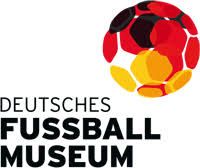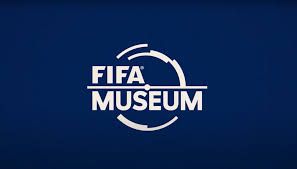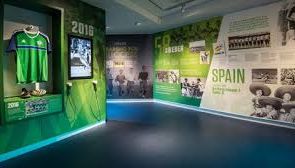Museums
- the Good, the Poor and the Ugly in Spirit
This summer we have had the opportunity to visit and revisit a number of "Football Museums" both in Britain and on Continental Europe. And here quite simple are our assessments of what what they offer to those of any age with some interest in football history rather than simply a means to keep the weans amused for the day.

First up is Manchester's National Football Museum, which is not national, if Britain is a nation, but has inherited its title from its earlier days at Preston and did not use the opportunity of the move to amend it to English National Football Museum or even simply The English Football Museum.
But there are funding restaints. Its money comes from Manchester Council only. Nothing from the Englsih FA. But we are where we are. It, on the other hand, is house in an architecturally very interesting building in the north of the city-centre with good public-transport access and is on three floors, the first a lobby, the second the exhibition area and the third activities.
As to the exhibits the origins of football take up about a tenth of what is quite a small space and they and the lay-out are, shall we say, eclectic with, from our point of view, not a single reference to the huge contribution Scots made to the English game for over a century. Figures like Alex Ferguson, Matt Busby and Bill Shankly are featured but their personal and footballing origins North of the Border are not mentioned. And this strange approach starts on the very first display wall. On it there is a photograph of England international David Jack, without a hint that his father, also a professional footballer signed South, hailed from Alloa and his mother from Jersey. And it continues with Tadger Stewart, the 1888 Home Championship as the first won by outright England but only after three by Scotland and one shared. Then there is Wembley and Glasgow-born Archibald Leitch, woman's football and Lady Florence Dixie born in Dumfriesshire and John Kerr of the Dick, Kerr company from Glasgow, Arthur Warton as the first black professional footballer with no mention of Andrew Watson, and finally Arthur Kinnaird with no word that he was a Scotland international. And all this, good and poor, just now for £16.

And so to the next. That the German Football Museum is in Dortmund and not, for example, in Berlin, Frankfurt or Munich is interesting. In part it was due to funding but it works. The building is imposing, the entrance directly opposite the city's main railway station and wit it again on three floors it is easily spacious enough to do what is a fine exhibition justice, both in content and lay-out. And within that the homeland section understandably dominates but there is a very good section on the early history of the game, both in Germany and before that in Britain.
There are in the content some factual errors, but we hope we are helping to correct them, and there is also the inclusion of the usual, inherited tropes, German and general - in the case of the latter, for example, that folk-football was mob-football, that Association football had an almost exclusively English public-school derivation and toffs played it similarly, that in the early days England dominated it on-field etc.. But Germany is not alone in that and, whilst there remains work to be done, Germans are a logical people and facts are facts. So to sum up it is easy to get to, has very good exhibits, most of them also in English, is well-laid-out and well worth the E16 door money.

It has to be noted that of all the all the museums visited the FIFA museum is the only one that does not directly name the game. And that is for a simple reason. It is not dedicated to football but is a slightly offensive shrine to FIFA itself, which is a shame since the IFAB, also now based in Zurich, of which FIFA is but one member along with the FAs of the four nations of the United Kingdom, is the custodian of the laws, the "manners" the "spirit" of the sport. And "manners maketh man". FIFA should thus be seen as nothing more than a sometimes not very good tournament- organiser but somehow it has been lost.
Therefore and to quote, "The FIFA Museum in Zurich is generally considered worth visiting, especially for football (soccer) fans, but some visitors find it overpriced for what it offers." Interpretation of which might be that it is somewhat disingenuous about its scope, using the lure of the "Beautiful Game" to promote not it but itself and is done at a price that could, if content were done very, very well and comprehensibly, i.e. history past and story present, do justice to the former but cannot at SWF 26 at the door self-justify. Of its three floors just one third of one is devoted to the game's history and, whilst the content is largely correct, it is skimpy and frankly not enough. On the plus side, however, it is well-laid-out, colourful, if your thing is endless football shirts, has good activities for children, if your real interest is to use it as a soft-play area, and is very accessible by public transport.

The Education and Heritage Centre (EHC) at Windsor Park in Belfast in Northern Ireland was never intended to be a museum nor filled with relics of the past but rather an interactive, enjoyable and educational experience with wide-ranging audience appeal. And that it is, as well as small and colourful, concentrating on the Ulster. For Eire you have to look to the Irish Sports Museum in Dublin and now, it seems, Dun Laoghaire but it seems to be more about selling rather showing stuff.
And the adult cost of entry to the EHC, note, plus a tour of the stadium is £10.

In the case of the Scottish Football Museum it was not a visit but a revisit, in fact the latest in multiple revisits. And the problems the museum has are well-known. Being at Hampden Park it is not the easiest place to get to by public transport but then not impossible. Again only about a tenth of the floor space is given over to the history of the game, when Scotland was pivotal and top of the playing-tree. Too much is given over to the period from the Second World War, when, with a few notable exceptions, the national team was poor to bad. But there are considerable redeeming features.
The first are the exhibits themselves. They are more to-the-point and lively than remembered, although gaps remain even the modern era. The special exhibitions, currently Football and Mining, are good. There are knowledgeable staff always on hand to question about what is there and other matters to do with the game. And they know their subjects. Moreover there is no soft-play. Bairns are there but for the history. And, whilst the exhibition space could be larger, the cost of entry at just £9 is well worth the money, in fact better value than FIFA certainly and even Manchester.
Back to the SFHG Home page